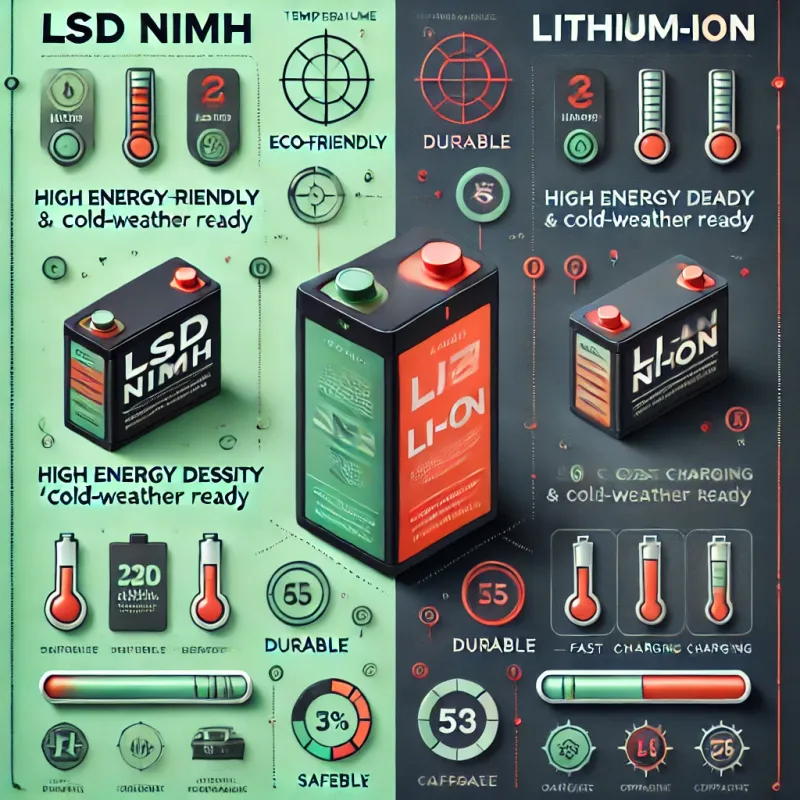LSD NiMH vs Lithium-Ion Batteries: Which is Right for You? | LiberIT

LSD NiMH vs. Lithium-Ion Batteries: Which is Right for You?
When it comes to choosing the right rechargeable battery for your devices or projects, two strong contenders are Low Self-Discharge (LSD) Nickel-Metal Hydride (NiMH) and Lithium-Ion (Li-ion) batteries. Each has its strengths and weaknesses, making them better suited for different applications. In this post, we’ll dive into their key features, compare their performance, and help you decide which one fits your needs.
What Are LSD NiMH Batteries?
LSD NiMH batteries are a modern version of traditional NiMH batteries. They retain their charge much longer than older models, making them far more convenient for everyday use. These batteries are pre-charged from the factory, retain 70–85% of their charge after a year, and can endure hundreds to thousands of recharge cycles.
What Are Li-ion Batteries?
Lithium-ion batteries are renowned for their high energy density and lightweight design. They power most of our modern gadgets, including smartphones, laptops, and electric vehicles. However, they require more precise handling and are more sensitive to deep discharges, overcharging, and extreme temperatures.
Head-to-Head Comparison: LSD NiMH vs. Li-ion
| Feature | LSD NiMH | Li-ion |
|---|---|---|
| Energy Density | Moderate: 60–120 Wh/kg | High: 150–250 Wh/kg |
| Self-Discharge Rate | ~10–15% per year | ~1–5% per month |
| Voltage per Cell | 1.2V | 3.6–3.7V |
| Cycle Life | 500–2,100+ cycles | 500–1,000+ cycles |
| Charging Time | 2–4 hours | 1–3 hours (fast charging supported in some models) |
| Operating Temperature | Excellent: -20°C to 50°C (-4°F to 122°F) | Limited: -20°C to 60°C (-4°F to 140°F) for discharging; 0°C to 45°C (32°F to 113°F) for charging |
| Deep Discharge Tolerance | High: Can tolerate deep discharges | Low: Deep discharges can damage the battery |
| Safety | Very safe; resistant to overheating and thermal runaway | Requires a battery management system (BMS) for safety |
| Weight and Size | Heavier and bulkier for the same energy capacity | Lightweight and compact |
| Environmental Impact | Eco-friendly, easier to recycle | Complex recycling process with hazardous materials like cobalt |
| Cost | Affordable upfront | Higher upfront cost |
Key Advantages of LSD NiMH Batteries
- Cold-Weather Performance: Retains capacity better in sub-zero temperatures, making it ideal for outdoor devices or emergency equipment.
- Deep Discharge Tolerance: Can recover from full discharges without significant loss in performance.
- Safety and Durability: Highly resistant to overcharging, overheating, and physical abuse.
- Eco-Friendly: Easier to recycle, with no toxic heavy metals like cadmium or cobalt.
- Applications: Perfect for household devices, flashlights, toys, hybrid vehicles, and DIY projects.
Key Advantages of Li-ion Batteries
- High Energy Density: Packs more energy into a smaller and lighter battery, making it ideal for portable electronics.
- Low Self-Discharge: Retains a charge for months with minimal energy loss.
- Fast Charging: Supports rapid charging for quick turnarounds.
- Applications: Best suited for smartphones, laptops, electric vehicles, and renewable energy storage.
Which One Should You Choose?
The choice between LSD NiMH and Li-ion batteries depends on your needs:
-
Choose LSD NiMH if you value:
- Durability, safety, and tolerance for deep discharges.
- Cold-weather performance for outdoor or emergency devices.
- Cost-effective and eco-friendly options for household or DIY use.
-
Choose Li-ion if you need:
- High energy density for compact, lightweight devices.
- Long-term storage with minimal self-discharge.
- High-performance solutions for portable electronics and high-tech applications.
Final Thoughts
Both LSD NiMH and Li-ion batteries have their place in the world of energy storage. While Li-ion dominates modern technology with its energy density and lightweight design, LSD NiMH batteries offer a reliable, durable, and eco-friendly alternative for everyday applications. By understanding their differences, you can make an informed decision and get the most out of your battery-powered devices.
Which type of battery do you prefer? Let us know in the comments!